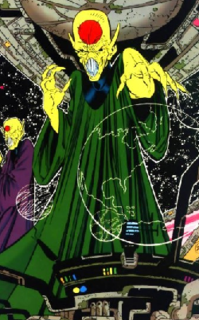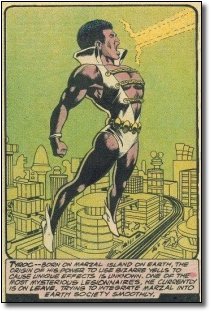| Invisible Kid | |
|---|---|
| Publication information | |
| Publisher | DC Comics |
| First appearance | Legion of Super-Heroes (vol. 2) Annual # 1 (1982) |
| Created by | Paul Levitz Keith Giffen (based upon the Lyle Norg character by Jerry Siegel and Jim Mooney) |
| In-story information | |
| Alter ego | Jacques Foccart |
| Species | Metahuman |
| Place of origin | Earth (31st century) |
| Team affiliations | Legion of Super-Heroes |
| Abilities | Ability to stay undetected from many kinds of means (ocular, auditory and telepathic) Formerly: Teleportation |
Jacques Foccart is a comic book character, a superhero in the DC Comics universe and the second to assume the name Invisible Kid. He is a member of the Legion of Super-Heroes in the 30th and 31st centuries. As his code name suggests, he possesses the superhuman ability to become invisible.

A comic book or comicbook, also called comic magazine or simply comic, is a publication that consists of comics art in the form of sequential juxtaposed panels that represent individual scenes. Panels are often accompanied by descriptive prose and written narrative, usually, dialog contained in word balloons emblematic of the comics art form. Although comics has some origins in 18th century Japan, comic books were first popularized in the United States and the United Kingdom during the 1930s. The first modern comic book, Famous Funnies, was released in the U.S. in 1933 and was a reprinting of earlier newspaper humor comic strips, which had established many of the story-telling devices used in comics. The term comic book derives from American comic books once being a compilation of comic strips of a humorous tone; however, this practice was replaced by featuring stories of all genres, usually not humorous in tone.
In fiction, a character is a person or other being in a narrative. The character may be entirely fictional or based on a real-life person, in which case the distinction of a "fictional" versus "real" character may be made. Derived from the ancient Greek word χαρακτήρ, the English word dates from the Restoration, although it became widely used after its appearance in Tom Jones in 1749. From this, the sense of "a part played by an actor" developed. Character, particularly when enacted by an actor in the theatre or cinema, involves "the illusion of being a human person". In literature, characters guide readers through their stories, helping them to understand plots and ponder themes. Since the end of the 18th century, the phrase "in character" has been used to describe an effective impersonation by an actor. Since the 19th century, the art of creating characters, as practiced by actors or writers, has been called characterisation.

A superhero is a type of heroic stock character, possessing supernatural or superhuman powers, who is dedicated to fighting the evil of their universe, protecting the public, and usually battling super-villains. A female superhero is sometimes called a superheroine, although the word superhero is also commonly used for females. Superhero fiction is the genre of fiction that is centered on such characters, especially in American comic book and films since the 1930s.













